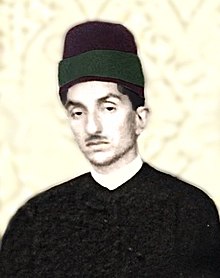Abdul Saleh al-Killidar
Sayyid Abd al-Saleh Abd al-Husayn al-Killdar Tumah (Arabic: عبد الصالح عبد الحسين الكليدار آل طعمه; 1911–October 30, 2005) was an Iraqi nobleman that served as the 55th custodian of the Imam Husayn shrine from 1931 until 1981.[1][2][3]
Abdul Saleh al-Killidar | |
|---|---|
السيد عبد الصالح الكليدار | |
 | |
| 55th Custodian of the Imam Husayn Shrine | |
| In office May 18, 1931 – June 7, 1981 | |
| Preceded by | Abdul Husayn al-Killidar |
| Succeeded by | Adel al-Killidar |
| Personal details | |
| Born | Abd al-Saleh Abd al-Husayn Ali Tumah 1911 Karbala, Ottoman Empire |
| Died | October 30, 2005 (aged 93–94) London, England |
| Resting place | Karbala |
| Relatives | Dhia Jafar (first cousin) |
Biography
al-Killidar was born in 1991 to Abdul Husayn al-Killidar.[4] He is from the Tumah branch of the Al Faiz family. His grandfather Jawad took on the name al-Killidar (Arabic: الكليدار) which roots from kileet (Persian: كليت) dar (Persian: دار), which translates to key holder in Persian, a name often given to those that take on the role of tending to holy shrines.[5] His mother is the daughter of renowned merchant, Abd al-Hadi al-Astarabadi. His maternal uncle, Mahmoud al-Astarabadi, was a member of the senate in the royal era for the city of Kadhimiya.[6][7]
He grew up and completed his high school studies in Karbala, and in 1928, his father passed down the sidana as he was going to become a member of the Iraqi senate in Baghdad. He took responsibility of the sidana in 1928, was officially assigned in 1931.[8]
al-Killidar helped rebuild his fathers library, after it was burnt in the Hamza Bey incident of 1915.[9][10]
In 1966, al-Killidar renewed the clock of the shrine, that was gifted by Naser al-Din Shah in 1891. al-Killidar imported the clock from Germany, and it remained in the shrine until the 1991 uprising, where it was destroyed during one of the Baathist helicopter gunship attacks.[11]
al-Killidar retired on June 7, 1981, after serving for just under 50 years, and passed down the custodianship to his son, Adel.[12]
Personal life
al-Killidar was married to his second cousin, once removed. She was the daughter of Khalil al-Astarabadi (1877–1970), the last mayor of Karbala under the Hashemite monarchy.[13] He had two sons, Adel (who became the saden after him) and Ali (d. 2018; dean of engineering at University of Baghdad). al-Killidar was fluent in English and Persian.[8]
Death
al-Killidar died on Sunday October 30, 2005, in his home in London. His body was transferred to Karbala to be buried.
See also
References
- Ṭuʻmah, Salmān Hādī (1998). Asha'er Karbala Wa 'Usariha [Tribes and Families of Karbala] (in Arabic). Beirut, Lebanon: Dar al-Mahaja al-Baydha'. p. 144.
- al-Fadala, Dr. Saleh (2013). al-Jawhar al-Afeef Fi Ma'rifat al-Nasab al-Nabawi al-Sharif [The Noble Prophetic Lineage]. Beirut, Lebanon: Dar al-Kotob al-Ilmiyah. p. 566. ISBN 9782745178664.
- al-Jibouri, Kaamil Salman (2003). Mu'jam al-'Udaba' Min 'Asr al-Jahili Hata Sanat 2002 [Glossary of Scholars: From the Jahiliyyah to 2002 AD] (in Arabic). 3. Beirut, Lebanon: Daar al-Kitab al-'Ilmiya. p. 335.
- al-Killidar, Abd al-Husayn. Baghiyat al-Nubala Fi Tarikh Karbala (in Arabic). Baghdad, Iraq: Matba'at al-Irshad. p. 125.
- al-Karbassi, Ayatullah Sheikh Sadiq (1 February 2014). Tarikh al-Sidana al-Hussainiya [The History of the Custodianship of Imam Hussain's Shrine] (in Arabic). Hussaini Charitable Trust. p. 31. ISBN 978-1-908286-99-4.
- Gaury, Gerald De (1961). Three Kings in Baghdad, 1921-1958. Hutchinson. pp. 196–97.
- "الوزيرالسعيدنورييتـذكرجعـفرضيـــاء" (PDF). Retrieved 19 May 2020.
- Tumah, Salman Hadi (1996). Tarikh Marqad al-Husayn wal-Abbas alayhima al-salam [History of the shrines of Husayn and Abbas peace be upon them] (in Arabic). Beirut, Lebanon: Mu'asasat al-A'lami Lil Matboo'at. p. 213.
- "Maktabat al-Sayyid Abd al-Husayn al-Killidar Al Tumah" [Sayyid Abdul Husayn al-Killidar's Library]. imamhussain.org (in Arabic). Retrieved 2020-06-24.
- Ṭuʻmah, Salmān Hādī (1983). Turath Karbala [Heritage of Karbala] (in Arabic). Beirut, Lebanon: Mu'asasat al-A'lami lil-Matboo'at. p. 323.
- "Sa'at al-Haram al-Husayni Taduq Min Jadid" [The clock of the Husayn Shrine ticks once again]. www.alliraqnews.com (in Arabic). Retrieved 2020-06-25.
- al-Karbassi, Ayatullah Sheikh Sadiq (1 February 2014). Tarikh al-Sidana al-Hussainiya [The History of the Custodianship of Imam Hussain's Shrine] (in Arabic). Hussaini Charitable Trust. p. 127. ISBN 978-1-908286-99-4.
- "Muthakarat al-Haj Khalil al-Astarabadi Ra'is Baladiyat Karbala 1930-1958, t 1970" [Diary of Haj Khalil al-Astarabadi Mayor of Karbala 1930-1958, died 1970]. www.azzaman.com (in Arabic). Retrieved 2020-06-26.